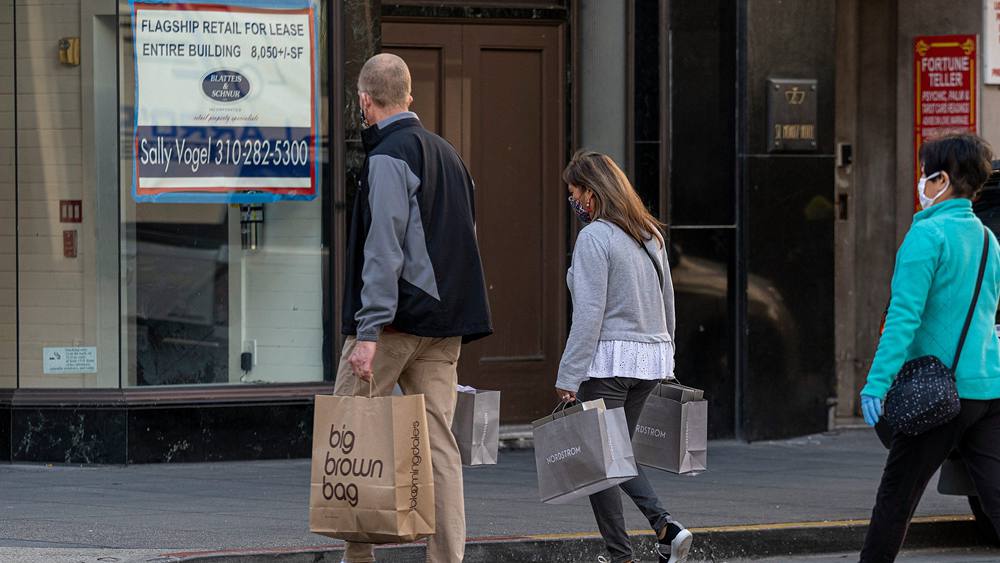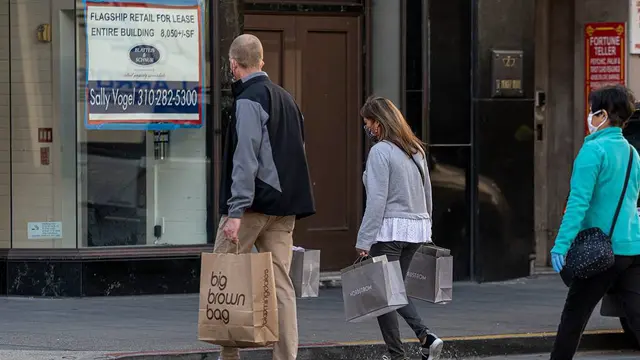
Pedestrians carry shopping bags in San Francisco, California, U.S., February 17, 2021. /CFP
Editor's note: Jimmy Zhu is chief strategist at Fullerton Research. The article reflects the author's opinion, and not necessarily the views of CGTN.
U.S. inflation jumped 4.2 percent from a year ago, according to data released on May 12, and that further confirms the inflation in the largest economy may get out of the Fed's control, at least for the near term. Actually the weaker-than-expected U.S. jobs data last week had already reflected how inflation was going to rise, not fall.
The U.S. April payrolls rose 266,000 from a month earlier, well below market expectations. The unemployment rate edged up to 6.1 percent, though the labor-force participation rate also increased. After the weaker-than-expected jobs report, the U.S. stocks gained on the day, showing that the investors believed the Fed would have to keep the easy monetary policies for a long period of time.
However, the optimism didn't last long, as the stocks have been selling off heavily this week. The Dow index dropped over 1.3 percent on Monday and Tuesday, while the Nasdaq composite index slid over 2.5 percent in this period. Heavy sell-off in the Nasdaq index reflected the fears on higher interest rates because high-growth tech firms' revenues relies heavily on cheap borrowing costs. Sell off in Wall Street seems to contradict what the U.S. jobs report described, but traders could be right: A weak labor market points to higher inflation for this time.
Some evidence showed that the recent slow pace in jobs growth was largely due to a labor shortage when many companies are still actively trying to look for candidates. Data released on Tuesday by the Department of Labor showed that job openings in the U.S. exceeded 8 million in March for the first time ever, higher than the 7.5 million jobs in February, and the numbers are well above pre-pandemic levels. However, many factors are causing Americans to refrain from returning to the labor force. More importantly, all these factors may further accelerate inflation in the U.S.
Supply-chain shortage
ISM manufacturing PMI business employment index dropped to 55.1 in April from 59.6 in the previous month, but the service employment index rose to 58.8 versus 57.2 in March. The divergence between the two further confirmed the recent supply shortages driven by the issues with shipping, demand, supply and all the other levers of the manufacturing sector, while the service sector is less affected by these factors.
Divergence in the manufacturing and service sectors' hiring pace was largely due to supply-chain shortage from cars, chips and consumer electronics, as the pandemic interrupted shipping, demand, supply and all the other levers of the economy. If this phenomenon continues, commodity prices are set to further rise. This will certainly hurt the labor market for some time because less production means both employers and workers will find fewer incentives to run more projects.
Asset's bubble
This is another key reason to discourage people to go out searching for work, especially for young people. In the first four months of the year, the SP 500 has rallied around 13 percent. The gain in stocks helps many people who are no longer financially stressed. According to job search site ZipRecruiter, only 35 percent of job seekers felt financial pressure to take the first job offer they received, much lower than 51 percent in 2018 when the global economy was suffering from the trade tensions between the two largest economies.
Higher asset prices help ease credit risk and promote consumption, but also make people wealthier and therefore find it unnecessary to work in the office. If this becomes the trend, it will complicate the Fed's handling of monetary policy. If asset valuations are too expensive, it will make the Fed's policy become inflexible as policymakers need to put market reaction into consideration to avoid a spike in volatility before they intend to shift policy. The longer the Fed keeps the ultra-dovish monetary policy, the higher the inflation rate goes.
Skill mismatch
The pandemic caused many people to leave the labor force a year ago. Those who have stopped working for a long period of time may have lost some working skills. Now that the economy started reopening, this group of people may find it difficult to match employers' requirements, which is part of the reason behind the shortage in the labor force.
Thus, the existing people in the labor force may find it easier to get a promotion or pay raise, causing the companies' operation costs to rise and most likely to transfer onto the price of products or services. In such a scenario, consumers may have to pay higher prices than what they paid in the past.
 简体中文
简体中文



